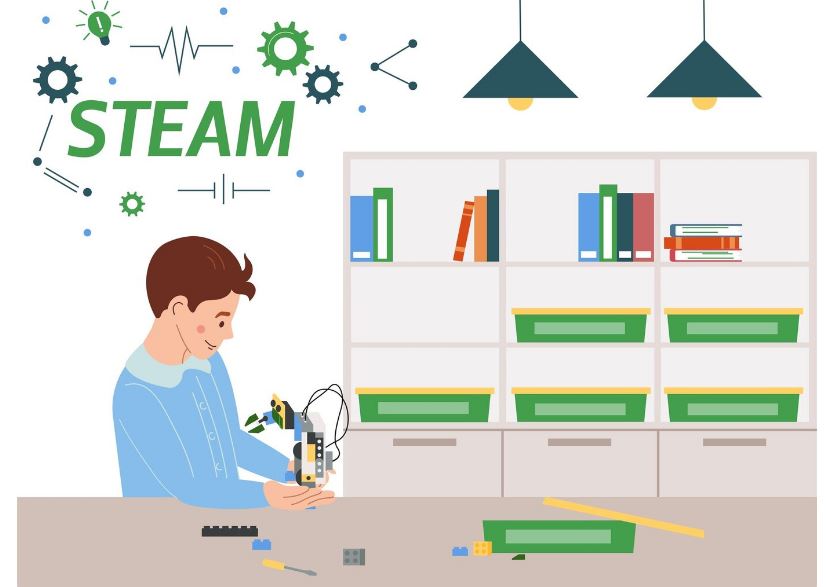
The way that young students investigate knowledge has been subtly but significantly altered over the last ten years by STEAM education. Schools have opened up new levels of engagement by fusing the expressive potential of the arts with the rigorousness of science and math. Students now see how music enhances math or how visual storytelling improves coding, rather than isolating subjects. Higher retention, greater creativity, and more self-assured students are the results of this change, which has been noticeably better across districts adopting STEAM.
While creating a solar-powered sculpture, a teacher at a California public magnet school recounted witnessing the blossoming of a reserved student. In a way that traditional tests could never do, the assignment, which combined engineering and artistic expression, captivated the child’s imagination. That student found a voice through the project’s design, development, and presentation. The teacher said that result was worth more than any grade.
STEAM Education Essentials
| Topic | Key Details |
|---|---|
| Definition | Integration of Science, Technology, Engineering, Arts, and Mathematics |
| Core Focus | Creative, hands-on, interdisciplinary learning |
| Key Benefits | Enhances innovation, critical thinking, adaptability, student motivation |
| Learning Methods | Project-based learning, design thinking, collaborative exploration |
| Who It’s For | K-12 students, teachers, curriculum leaders, policymakers |
| Common Tools | Robotics kits, art supplies, programming platforms, multimedia, 3D printers |
| Teaching Framework | Focus → Detail → Discovery → Application → Presentation → Link |
| Career Impact | Prepares for AI, biotech, architecture, design, digital arts, and sustainable engineering |
| Global Support | Adopted across U.S., U.K., Singapore, Finland, South Korea |
Even younger students have worked on projects that promote experimentation by utilizing resources like Makey Makey kits and stop-motion software. These encounters foster fundamental logic and go beyond simple play. Many schools now have access to equipment that was previously thought to be too expensive thanks to strategic partnerships, giving underserved communities more opportunities. For rural districts that did not previously have access to cutting-edge science labs, the movement has been especially helpful.
For curriculum designers, STEAM offers useful structure in addition to visual appeal. Every unit adheres to a design loop. Students start with a theme or problem. They investigate the problem, formulate concepts, produce solutions, test them, and report their results. This cycle is similar to how teams operate in the real world in fields like sustainability technology, gaming, and architecture. This process makes learning visible and meaningful, and it is remarkably effective at increasing student motivation.
Pupils who might have had difficulty in strict classroom settings are now succeeding. When creating a virtual city using both hand-sketched maps and architectural design apps, a seventh-grader with ADHD who is frequently distracted in traditional classes was surprisingly focused. His learning was balanced by the combination of digital and tactile work. Because of the project, he was able to confidently present to his class, expressing concepts related to urban planning in ways that his teachers had never seen before.
Remote STEAM lessons demonstrated the tremendous versatility of these methods during the pandemic. Instructors adjusted by asking students to turn everyday objects into tools, machines, or narrative devices. Despite the lack of classrooms, the philosophy persisted. It put creativity ahead of perfection. The best thinkers, not the best test-takers, were the ones who flourished during this period. They were incredibly adaptable, inquisitive, and resourceful.
Education officials in Singapore started implementing STEAM integration across the country. They observed an increase in student engagement when they incorporated coding into music and visual arts classes. Students were using digital sketchbooks to create scientific phenomena or programming light shows that were timed to music they had composed themselves. Deeper comprehension of the material and increased technological confidence were the results of these projects, which were especially creative in their design.
Through the American Rescue Plan, the Biden administration allocated funds for STEAM programs in the United States. The investments demonstrated a wider understanding that innovative problem-solving is critical to long-term economic stability. This change has resulted in an explosion of platforms that provide modular, multidisciplinary learning kits for edtech startups in their early stages. Schools are getting access to resources that were previously only available to prestigious institutions by working with tech companies and nonprofits.
Additionally, students who receive STEAM training are more employable. Not only do they comprehend STEM, but they are also able to collaborate, communicate, and adapt. Graduates with interdisciplinary experience are more likely to be adept at solving practical problems, according to employers. Applicants with STEAM backgrounds demonstrated “a sharper ability to frame problems creatively and execute with precision,” according to an HR executive from a biotech company.
Teachers have also noticed changes in their own methods. After learning about the model, a former physics teacher at a Boston high school switched to STEAM facilitation. She started directing student-led research instead of giving lectures. Her classroom grew noisier, more animated, and definitely more lively. Her energy also changed; she was energized by student-driven inquiry and no longer felt worn out by the pressure to teach flawless lessons.
The difficulty for medium-sized schools is frequently in updating equipment and retraining employees. However, districts that make a commitment frequently reap substantial benefits. Within two semesters of implementing STEAM, a school in Ohio saw a 38% increase in student attendance. Peer cooperation increased and bullying declined. These figures, which show both academic progress and cultural change, speak for themselves. These results were changes in attitude rather than merely figures on a spreadsheet.
Additionally, STEAM education promotes inclusivity. Visual and kinetic expression unites students from a variety of backgrounds, including those learning English as a second language. A Syrian immigrant student used stop-motion animation to recount his journey to the United States. His school district as a whole shared that project, which served as a benchmark for understanding and empathy. Such storytelling fosters connection and healing when it is made possible by the integration of art and technology.
